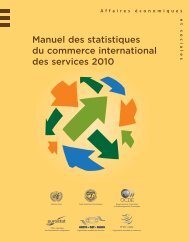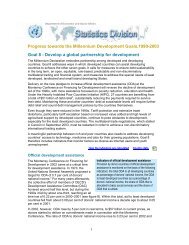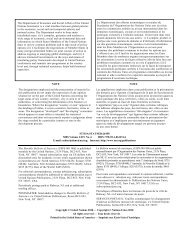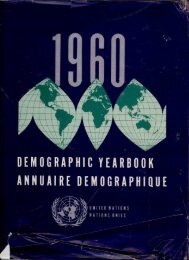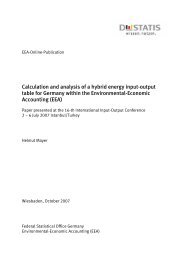dime NOTE The designations employed and the presentation of ...
dime NOTE The designations employed and the presentation of ...
dime NOTE The designations employed and the presentation of ...
You also want an ePaper? Increase the reach of your titles
YUMPU automatically turns print PDFs into web optimized ePapers that Google loves.
Data definitions<br />
industrial production indices: Laspeyres’s index number <strong>of</strong><br />
total value-added in all industrial production, where value<br />
added is <strong>the</strong> value <strong>of</strong> output less <strong>the</strong> values <strong>of</strong> both<br />
intermediate consumption <strong>and</strong> consumption <strong>of</strong> fixed capital.<br />
industrial products: Goods produced by resident institutional<br />
units in industries <strong>of</strong> mining, manufacturing <strong>and</strong> electricity,<br />
gas <strong>and</strong> water (22, para. 6.238).<br />
infant deaths: Infant deaths under one year <strong>of</strong> age (20, ID3).<br />
See also deaths rates, crude.<br />
intermediate goods: Goods consumed as inputs by a process<br />
<strong>of</strong> production, excluding fixed assets (22, para. 6.147).<br />
iron ore: CPC Vers. 1.1 (7) group 141: Iron ores <strong>and</strong><br />
concentrates, o<strong>the</strong>r than roasted iron pyrites.<br />
L<br />
lignite: Coal with a low degree <strong>of</strong> coalification that has<br />
retained <strong>the</strong> anatomical structure <strong>of</strong> <strong>the</strong> vegetable matter<br />
from which it was formed (6). CPC Vers. 1.1 (7): Lignite,<br />
whe<strong>the</strong>r or not agglomerated (class 1103).<br />
livestock: All domestic animals irrespective <strong>of</strong> <strong>the</strong>ir age <strong>and</strong><br />
<strong>the</strong> place or purpose <strong>of</strong> <strong>the</strong>ir breeding.<br />
M<br />
manufacturing: Comprises tabulation category D <strong>and</strong><br />
divisions 15-37 in <strong>the</strong> International St<strong>and</strong>ard Industrial<br />
Classification <strong>of</strong> All Economic Activities, Revision 3. It is<br />
defined as <strong>the</strong> physical or chemical transformation <strong>of</strong><br />
materials or components into new products, whe<strong>the</strong>r <strong>the</strong><br />
work is performed by power-driven machines or by h<strong>and</strong>,<br />
whe<strong>the</strong>r it is done in a factory or in <strong>the</strong> worker's home, <strong>and</strong><br />
whe<strong>the</strong>r <strong>the</strong> products are sold at wholesale or retail.<br />
Included are assembly <strong>of</strong> component parts <strong>of</strong> manufactured<br />
products <strong>and</strong> recycling <strong>of</strong> waste materials (16).<br />
mining <strong>and</strong> quarrying: Extraction, dressing <strong>and</strong> beneficiating<br />
<strong>of</strong> minerals occurring naturally: Solids, such as coal <strong>and</strong><br />
ores; liquids, such as crude petroleum; <strong>and</strong> gases, such as<br />
natural gas. Mining includes underground <strong>and</strong> surface<br />
mines, quarries <strong>and</strong> wells <strong>and</strong> all supplemental activities for<br />
dressing <strong>and</strong> beneficiating ores <strong>and</strong> o<strong>the</strong>r crude materials,<br />
such as crushing, screening, washing, cleaning, grading<br />
milling, flotation, melting, pelleting, topping <strong>and</strong> o<strong>the</strong>r<br />
preparations needed to render <strong>the</strong> material marketable (17,<br />
p.27).<br />
money, quasi-money: Money comprises transferable dem<strong>and</strong><br />
deposits <strong>of</strong> monetary authorities <strong>and</strong> deposit money banks<br />
(“M1”), o<strong>the</strong>r than those <strong>of</strong> <strong>the</strong> central government, <strong>and</strong><br />
currency outside banks plus, where applicable, private<br />
sector dem<strong>and</strong> deposits with <strong>the</strong> postal checking system <strong>and</strong><br />
with <strong>the</strong> Treasury. Quasi-money comprises time, savings,<br />
<strong>and</strong> foreign currency deposits <strong>of</strong> resident sectors o<strong>the</strong>r than<br />
central government. Money plus quasi-money is frequently<br />
called “M2” (4, Introduction, sect. 4). See also reserve<br />
money.<br />
motor vehicles: CPC Vers. 1.1 (7): Motor cars <strong>and</strong> o<strong>the</strong>r<br />
vehicles principally designed for <strong>the</strong> transport <strong>of</strong> persons<br />
(except public-transport type vehicles specially designed for<br />
travelling on snow, <strong>and</strong> golf cars <strong>and</strong> similar vehicles<br />
(subclass 49113).<br />
motor vehicles, new, registration: Registrations <strong>of</strong> new<br />
passenger cars <strong>and</strong> commercial motor vehicles put into<br />
circulation for <strong>the</strong> first time (21, p. 253).<br />
N<br />
natural gas: A mixture <strong>of</strong> hydrocarbon compounds <strong>and</strong> small<br />
quantities <strong>of</strong> non-hydrocarbons existing in <strong>the</strong> gaseous<br />
phase or in solution with oil in natural underground<br />
reservoirs (12). CPC Vers. 1.1 (7): Natural gas, liquified<br />
or in <strong>the</strong> gaseous state (class 1202).<br />
newsprint: Bleached, unsized or slack-sized printing paper,<br />
without coating, <strong>of</strong> <strong>the</strong> type usually used for newspaper;<br />
weight from 45-60 grams per square metre, usually with at<br />
least 70 per cent <strong>of</strong> <strong>the</strong> weight <strong>of</strong> fibrous material derived<br />
from mechanical pulp (21, p. 140). CPC Vers. 1.1 (7):<br />
Newsprint (subclass 32121).<br />
non-residential building: A building where half or more <strong>of</strong><br />
<strong>the</strong> floor area is intended for o<strong>the</strong>r than dwelling purposes<br />
(21, p. 168).<br />
P<br />
petroleum, crude: CPC Vers.1.1 (7): Petroleum oils <strong>and</strong> oils<br />
obtained from bituminous materials, o<strong>the</strong>r than crude;<br />
preparations not elsewhere classified containing by weight<br />
70 per cent or more <strong>of</strong> <strong>the</strong>se oils, such oils being <strong>the</strong> basic<br />
constituents <strong>of</strong> <strong>the</strong> preparations (group 333). Petroleum<br />
oils <strong>and</strong> oils obtained from bituminous minerals, crude<br />
(class 1201).<br />
pig iron including foundry: Various mineral aggregates from<br />
which iron metal is obtained by <strong>the</strong> conversion <strong>of</strong> various<br />
iron ores by reduction ei<strong>the</strong>r into pig iron, in blast furnaces<br />
or electric furnaces, or into a spongy form (sponge iron) or<br />
into lumps by various direct reduction processes. Iron ore is<br />
measured by <strong>the</strong> weight <strong>of</strong> <strong>the</strong> ore <strong>and</strong> may contain varying<br />
concentrations <strong>of</strong> metal. CPC Vers. 1.1 (7), (group 411):<br />
Basic iron <strong>and</strong> steel.<br />
population, estimate <strong>of</strong> total: <strong>The</strong> total population <strong>of</strong> a<br />
country may comprise ei<strong>the</strong>r all usual residents <strong>of</strong> <strong>the</strong><br />
country (de jure population) or all persons present in <strong>the</strong><br />
country (de facto population) at <strong>the</strong> time <strong>of</strong> <strong>the</strong> census. For<br />
purposes <strong>of</strong> international comparisons, <strong>the</strong> de facto<br />
definition is recommended (18).<br />
population, <strong>of</strong>ficial mid-year estimates: Estimates <strong>of</strong> <strong>the</strong> de<br />
facto population on 1 July provided by national statistical<br />
<strong>of</strong>fices (10, notes to table 3).<br />
producer price indices: <strong>The</strong> amount receivable by <strong>the</strong><br />
producer from <strong>the</strong> purchaser for a unit <strong>of</strong> a good or service<br />
produced as output minus any value-added tax, or similar<br />
deductible tax, invoiced to <strong>the</strong> purchaser. It includes any<br />
transport charges invoiced separately by <strong>the</strong> producer (22,<br />
para. 6.205). In principle, <strong>the</strong> PPI should include service<br />
industries, but in practice it is limited to <strong>the</strong> domestic<br />
agricultural <strong>and</strong> industrial sectors. <strong>The</strong> prices should be<br />
farm-gate prices for <strong>the</strong> agricultural sector <strong>and</strong> ex-factory<br />
for <strong>the</strong> industrial sector. <strong>The</strong> indices are computed using <strong>the</strong><br />
October 2009 - octobre 2009 292



